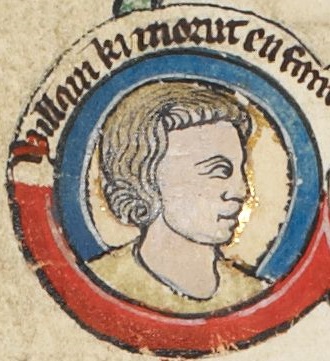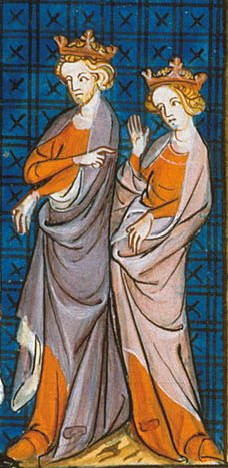by Susan Flantzer
© Unofficial Royalty 2022

William from an early 13th-century genealogical tree; Credit – Wikipedia
William IX, Count of Poitiers was the firstborn child of the future Henry II, King of England and Eleanor, Duchess of Aquitaine and Countess of Poitiers in her own right. He would have been King of England had he survived his father. William was born on August 17, 1153, in the County of Poitiers, now part of France, and was styled Count of Poitiers. At the time of William’s birth, his father was known as Henry FitzEmpress and was the Count of Anjou, Count of Maine, Duke of Normandy, and Count of Nantes, all in present-day France. William’s paternal grandparents were Geoffrey V, Count of Anjou, Touraine, and Maine, and Matilda of England, known as Empress Matilda, the widow of Heinrich V, Holy Roman Emperor. Matilda was the only surviving legitimate child of Henry I, King of England. William’s maternal grandparents were his namesake William X, Duke of Aquitaine and Aenor de Châtellerault.

William’s parents Henry and Eleanor; Credit – Wikipedia
William had two elder half-sisters from his mother’s annulled first marriage to Louis VII, King of France:
- Marie of France (1145 – 1198), married Henri I, Count of Champagne, had four children
- Alix of France (1151 – 1197/1198), married Theobald V, Count of Blois, had seven children

13th-century depiction of Henry and his legitimate children: (l to r) William, Young Henry, Richard, Matilda, Geoffrey, Eleanor, Joan, and John; Credit – Wikipedia
William had seven younger siblings although he was alive for the birth of only two:
- Henry the Young King (1155 – 1183), married Marguerite of France, no children
- Matilda of England, Duchess of Saxony and Bavaria (1156 – 1189), married Heinrich the Lion, Duke of Saxony and Bavaria, had five children, including Otto IV, Holy Roman Emperor
- King Richard I of England (1157 – 1199), married Berengaria of Navarre, no children
- Geoffrey II, Duke of Brittany (1158 – 1186), married Constance, Duchess of Brittany, had three children
- Eleanor of England, Queen of Castile (1162 – 1214), married King Alfonso VIII of Castile, had twelve children including King Enrique I of Castile; Berengaria, Queen Regnant of Castile and Queen of León; Urraca, Queen of Portugal; Blanche, Queen of France, and Eleanor, Queen of Aragon
- Joan of England, Queen of Sicily (1165 – 1199), married (1) King William II of Sicily, no surviving children (2) Raymond VI, Count of Toulouse, had two children, Joan died in childbirth with her third child who also died
- King John of England (1166 – 1216), married 1) Isabella, 3rd Countess of Gloucester, marriage annulled, no children (2) Isabella, Countess of Angoulême; had five children, including King Henry III of England; Joan of England, Queen of Scots, and Isabella of England, Holy Roman Empress
At the time of William’s birth, his father Henry was involved in a long civil war for the throne of England known as The Anarchy (1135 – 1153) between Empress Matilda (Henry FitzEmpress’ mother and the only surviving legitimate child of Henry I, King of England) and her first cousin Stephen of Blois, King of England since 1135. Stephen unsuccessfully attempted to have his son Eustace, recognized by the Church as the next King of England. By the early 1150s, most of the barons and the Church wanted long-term peace.
Finally, the armies of Henry FitzEmpress and King Stephen of England met at Wallingford in Oxfordshire, England. Pressured by the barons, Stephen called a ceasefire and agreed to a truce, over the objections of his son Eustace. Eustace flew into a rage and plundered church lands of the Abbey of Bury St Edmunds in Suffolk, England. On August 17, 1153, Eustace, aged about twenty-three, died suddenly. Various chroniclers of the time attribute Eustace’s death to the wrath of God for plundering church lands, a fever, a fit of madness, or poisoning. Ironically, the death of Eustace, King Stephen’s heir, and the birth of William, Henry FitzEmpress’ firstborn child occurred on the same day.
Shortly after Eustace’s death, King Stephen and Henry FitzEmpress reached a formal agreement known as the Treaty of Wallingford. The treaty allowed Stephen to keep the throne until his death but forced him to recognize Empress Matilda’s son Henry FitzEmpress, as his heir. Henry and Eleanor were finally reunited in Rouen, Duchy of Normandy at Easter in 1154, where Henry met his eight-month-old son William for the first time.
King Stephen survived for a little more than a year after the death of Eustace, dying on October 25, 1154, and a line of fourteen Plantagenet kings who ruled England until 1485 started, with Henry FitzEmpress, now King Henry II of England. In December 1154, Henry and Eleanor, now King and Queen of England, sailed to England from Normandy with their son William, where their coronation was held at Westminster Abbey on December 19, 1154.
On February 28, 1155, Eleanor gave birth to a second son named Henry after his father. In April 1155, Henry II and Eleanor brought their two young sons to Wallingford in Oxfordshire, England to present them to the English barons and clergy, and to command them to swear allegiance to William as his father’s heir and then to Henry as successor in the event of William’s early death.
For centuries, the Dukes of Aquitaine held the Count of Poitiers as a minor title, and so it had passed to Eleanor from her father. However, Eleanor separated the County of Poitiers from the Duchy of Aquitaine and gave the title of Count of Poitiers to her son William, making him the reigning Count of Poitiers as William IX.
In 1156 (date uncertain), William died at Wallingford Castle in Oxfordshire, England, aged two or three. The circumstances of his death are uncertain but some sources say he died from convulsions. William was buried at the feet of his great-grandfather Henry I, King of England at Reading Abbey in Reading, England, which was mostly destroyed during King Henry VIII’s Dissolution of the Monasteries.
This article is the intellectual property of Unofficial Royalty and is NOT TO BE COPIED, EDITED, OR POSTED IN ANY FORM ON ANOTHER WEBSITE under any circumstances. It is permissible to use a link that directs to Unofficial Royalty.
Works Cited
- Barber, Richard, 1964. Henry Plantagenet. New York: Barnes and Noble.
- De.wikipedia.org. 2022. Wilhelm von Poitiers (Prinz) – Wikipedia. [online] Available at: <https://de.wikipedia.org/wiki/Wilhelm_von_Poitiers_(Prinz)> [Accessed 14 August 2022].
- En.wikipedia.org. 2022. William IX, Count of Poitiers – Wikipedia. [online] Available at: <https://en.wikipedia.org/wiki/William_IX,_Count_of_Poitiers> [Accessed 14 August 2022].
- Flantzer, Susan, 2016. Eleanor, Duchess of Aquitaine, Queen of England. [online] Unofficial Royalty. Available at: <https://www.unofficialroyalty.com/eleanor-of-aquitaine-queen-of-england/> [Accessed 14 August 2022].
- Flantzer, Susan, 2016. King Henry II of England. [online] Unofficial Royalty. Available at: <https://www.unofficialroyalty.com/king-henry-ii-of-england/> [Accessed 14 August 2022].
- Fr.wikipedia.org. 2022. Guillaume IX de Poitiers — Wikipédia. [online] Available at: <https://fr.wikipedia.org/wiki/Guillaume_IX_de_Poitiers> [Accessed 14 August 2022].
- Weir, Alison, 1999. Eleanor of Aquitaine: By Wrath of God, Queen of England. London: Jonathan Cape.
